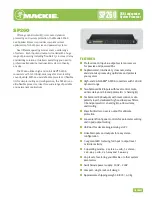
2-25
2
RS-422 or RS-485 interfaces do not have a standard interface connector.
Our recommendation is to use a 9 pin or smaller connector. The 4867/
2367's RS-422 interface operates in the full or half-duplex mode. For RS-
485 applications, connect the SD and RD pairs together and set the board
for half-duplex operation. The 4867/2367 board has pullup and pulldown
resistors that can be used to bias the RS-485 signals to the mark (logic '1')
condition when they are not being driven. Add a 220 ohm load resistor to
complete the termination network. For short distances of 100 feet or less,
only one termination network is required. For longer cable lengths, the user
should provide a similar termination network at the both ends of the serial
link.
2.9.6.3 LED Header
The LED Header J7 contains the signals listed in Table 2-8 for driving a
remote set of 4867/2367 LEDs. The LED Header is a 7-pin male header
with 0.025 square pins on 0.1 centers. See Figure 2-10. The LED drive
signals are low true and sink 2.5 mA. The remote LEDs may be powered
by the +5 volts on pin 1.
TABLE 2-8 LED HEADER PIN ASSIGNMENTS
Pin
Signal
Function
1
Vcc
+ 5 Vdc
2
Gnd
Signal Ground
3
ERR#
ERROR LED
4
SRQ#
SRQ LED
5
LSTN#
LSTN LED
6
TALK#
TALK LED
7
RDY#
READY LED
2.9.6.4 GPIB/Address Switch Header J5
The GPIB/Address Switch header J5 is the same as the header described in
paragraph 2.9.2 for the 4807. Refer to Table 2-1 for the signal-pin
assignments. Use the
SYST:COMM:GPIB:ADDR:EXT 1
command to
enable the external address switch.
















































